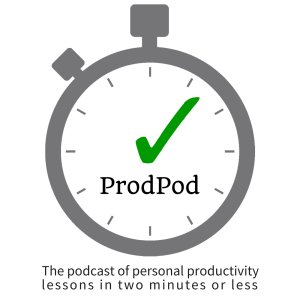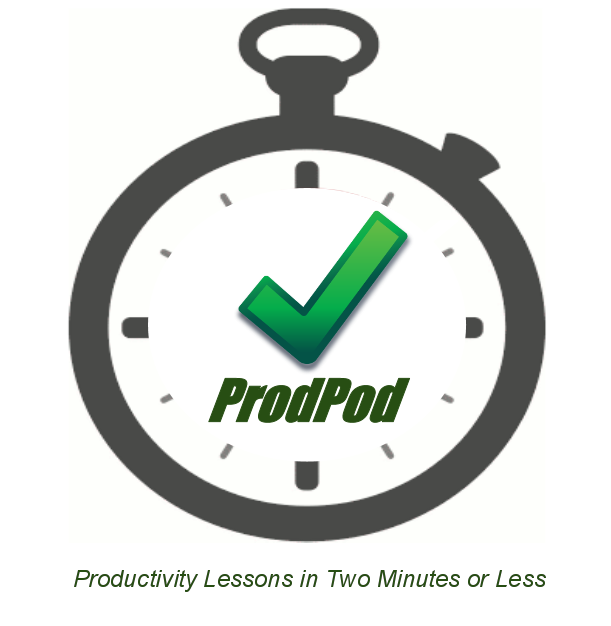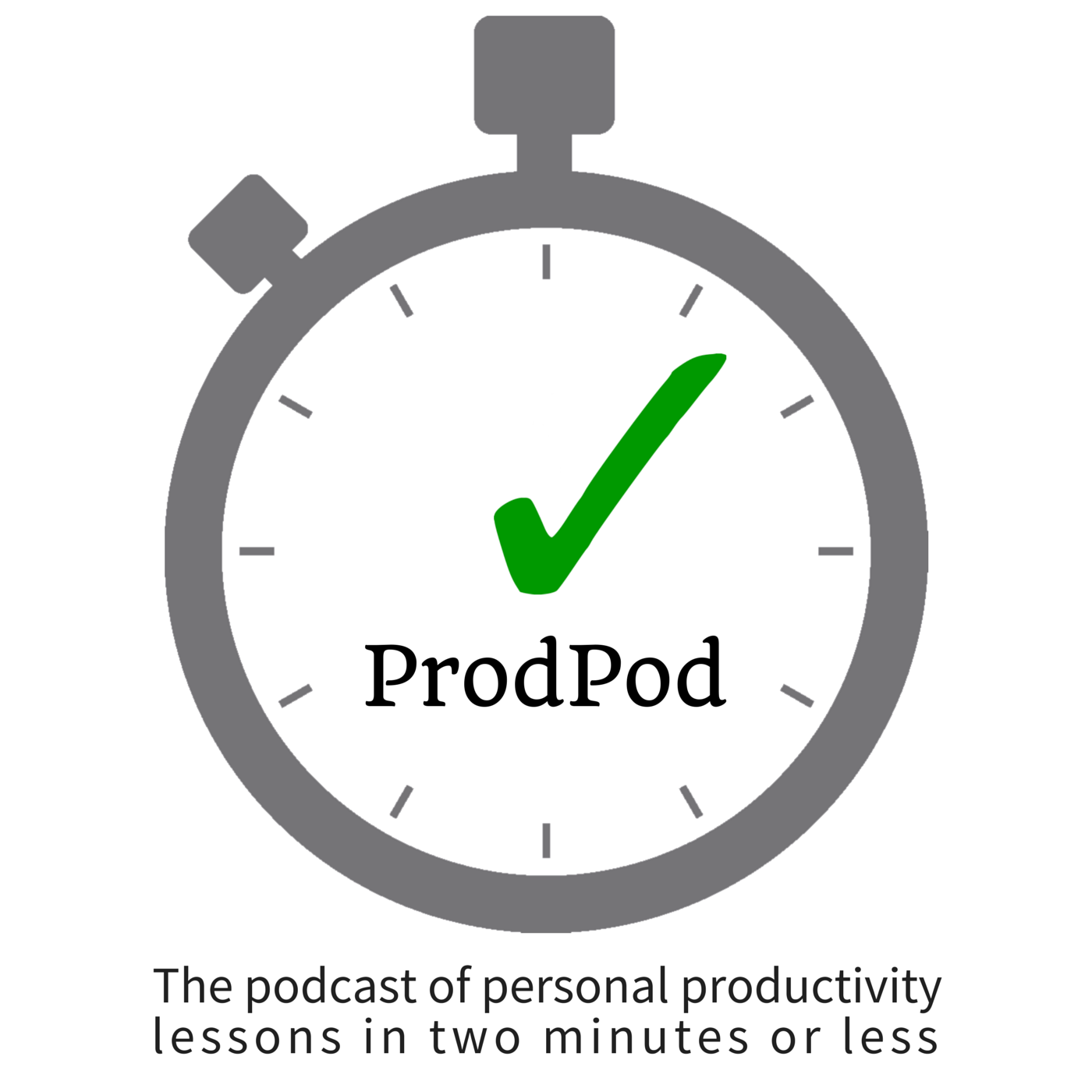Episodes

Thursday May 01, 2014
ProdPod: Episode 83 -- 31 Folders Instead of the GTD 43 Folders
Thursday May 01, 2014
Thursday May 01, 2014
If you are familiar with Getting Things Done by David Allen, or the GTD methodology, you probably know about the 43 folders concept. If you don’t, basically, it’s a tickler file-like tool where physical, time-based items can be managed. There are, you guessed it, 43 folders, constituting 12 file folders for the 12 months in the year and 31 folders representing the maximum number of days in any given month. In this episode I’d like to detail how I simplified this powerful paper organization tool, and hope it’s useful to those out there that still have much paper-based organizing in their worlds like I do.

Friday Apr 25, 2014
ProdPod: Episode 82 -- Procrasti-Doing
Friday Apr 25, 2014
Friday Apr 25, 2014
There’s a common misconception about procrastination that it only means you’re not doing something you planned to do. Many times we are unaware that procrastination is usually coupled with doing something, if not the thing we planned. This is what I call “procrasti-doing.” And there are some practical measures you can take to procrasti-doing when you want, and when you don’t, so I thought I’d explain them here in this episode.
One of the frequent stories I hear is something like this: “I was supposed to be working on my project, but instead I found myself rearranging the pens and pencils in my drawer.” This is the first classic case of procrasti-doing. One tactic for overcoming this is to think about whether or not your pens and pencils really do need organizing. If that is the case, then perhaps putting that on a project or task list for you to handle later would help you free up the mental bandwidth to get back on task. That goes for any other tasks or projects that might be floating around in your head as you set yourself up to handle any project. This minimizes procrasti-doing and maximizes your brain’s energy to focus.
The other case where procrasti-doing takes hold of us often is when you start doing the tasks in a project out of order or unimportant tasks associated with a project that really won’t move the project toward completion. This might include re-labeling all the project support folders for a major project. Or, one might take to Social Media to engage there about the project instead of actually working on the tasks toward the project’s completion. In this situation, the best approach is two-pronged: first, allow yourself a set amount of time to close out the current activity when you find yourself doing the unproductive procrasti-doing, then re-focus back on starting the next task toward project completion. Remember, it’s about (as Dr. Neil Fiore says in “The Now Habit”) persistent starting.
One final thought I have about procrasti-doing: many times your unconscious mind needs time to problem-solve the project or task you are currently trying to work on. In these cases, it might make perfect, productive sense for you to let your mind wander to other activities while your unconscious does the heavy lifting necessary to help you craft an effective solution. Organizing pens and pencils never sounded so productive.

Friday Jan 10, 2014
ProdPod: Episode 81 -- Productivity and Your Two Minds
Friday Jan 10, 2014
Friday Jan 10, 2014

Tuesday Dec 24, 2013
ProdPod: Episode 80 -- Setting Up Your Workspace for Success
Tuesday Dec 24, 2013
Tuesday Dec 24, 2013
Having just finished the ProdPod series on Hoarding, I've got workspaces on the mind. And, when it comes to personal productivity, there's nothing like showing up to your home or work office workspace and seeing it set up just for you. So, in this episode, I'm going to discuss a method for making your workspace work for you every day.
Assess Your Workspace
Organization doesn't naturally happen. So, the first step is to assess your situation. Do you feel like the way things are set up in your workspace flowing well? Or, do you find there is friction when you try to access your files, when you see clutter or piles of things in particular places in your workspace, or do you trip over a coat hanger when you enter the office every day? These are the things to note that need to change to make your workspace more productive.Brainstorm and Design Your Ideal Workspace
Now that you know what needs to change, create a new project in your productivity system. Rome nor your workspace was built in a day, so you can't fix all these minor nuisances or hiccups in your productive flow in a day. Now, what do you physically need to do with each problem you noted? Do you need to call an electrician to move a light switch? Do you need to call a carpenter to put a bookshelf in just the right place for your reference books? Write down or input those actions on your written list or in your task management software or app.Create Your Workspace Rituals
In addition, I have created Morning and Midday Rituals that help me break my day into productive chunks and makes sure that I'm tidying my workspace, filtering through my RSS feed reader and then purging that inbox at least daily midday, and creating time to process my email inboxes as well as making outbound phone calls to clients, vendors, staff, colleagues and my family.
Once your physical workspace is in order, and you have the morning, midday and end-of-day rituals designed to keep your workspace in tip-top shape, you'll quickly start to reap the productive rewards of flowing effortlessly through your days. Let me know your successes and challenges by email or in the comments!

Tuesday Dec 17, 2013
Tuesday Dec 17, 2013
Ray: In this final episode of this ProdPod series on hoarding, I asked Professional Organizer Sally Reinholdt to detail how hoarding is treated and managed. Sally, take it away.
Sally: The treatment and management of severe hoarding is very complex and needs to be addressed by a comprehensive team that can include mental health professionals, professional organizers, as well as junk removal and environmental clean-up companies. From a mental health aspect, traditional talk therapy has not been found to be helpful. Dr. David Tolin [ http://www.drtolin.com ], a psychologist who has worked extensively with hoarders, uses a cognitive behavioral approach that is active and solution focused. The hoarders he works with learn to sort and let go of their possessions in conjunction with thinking through their urges to constantly acquire. Hoarders are also taken on non-acquiring trips where they learn to see and touch items without keeping them. Using these methods, the majority of Dr. Tolin’s patients show significant improvement in their levels of clutter and their feelings around the clutter. That being said, a low number of patients are considered cured. Most patients will still have more clutter than the average person and will need ongoing support to prevent backsliding.
Ray: If you're interested in Dr. Tolin's work and how it may help you, check out his fantastic book, Buried in Treasures: Help for Compulsive Acquiring, Saving, and Hoarding [ http://amzn.to/18FCpdx ]. Also, Dr. Tolin is the founder of the Institute of Living [ http://goo.gl/5sRsgK ] in Hartford, CT, so you may want to seek them out if you happen to be the greater New York metropolitan area.
Ray: Well, thanks so much for joining me on ProdPod for this series about Hoarding, Sally. If you want to learn more about Sally Reinholdt and her professional organizing services head over to her website, COSOLVA.COM [ http://www.cosolva.com ].

